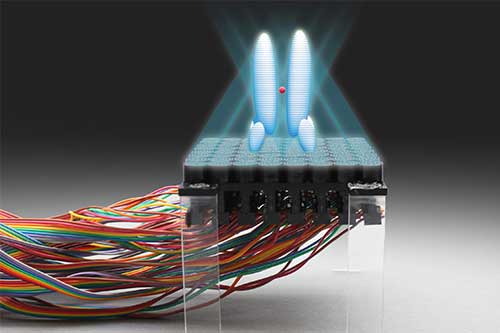Holographic sonic tractor beam lifts and moves objects using soundwaves
October 27, 2015

Holograms (3-D light fields) can be projected from a 2-dimensional surface to control objects. (credit: Asier Marzo, Bruce Drinkwater and Sriram Subramanian)
British researchers have built a working Star-Trek-style “tractor beam” — a device that can attract or repel one object to another from a distance. It uses high-amplitude soundwaves to generate an acoustic hologram that can grasp and move small objects.
The technique, published in an open-access paper in Nature Communications October 27, has a wide range of potential applications, the researchers say. A sonic production line could transport delicate objects and assemble them, all without physical contact. Or a miniature version could grip and transport drug capsules or microsurgical instruments through living tissue.
The device was developed at the Universities of Sussex and Bristol in collaboration with Ultrahaptics.
University of Sussex | Levitation using sound waves
The researchers used an array of 64 miniature loudspeakers. The whole system consumes just 9 Watts of power, used to create high-pitched (40Khz), high-intensity sound waves to levitate a spherical bead 4mm in diameter made of expanded polystyrene.
The tractor beam works by surrounding the object with high-intensity sound to create a force field that keeps the objects in place. By carefully controlling the output of the loudspeakers, the object can be held in place, moved, or rotated.
Three different shapes of acoustic force fields work as tractor beams: an acoustic force field that resembles a pair of fingers or tweezers; an acoustic vortex, the objects becoming trapped at the core; and a high-intensity “cage” that surrounds the objects and holds them in place from all directions.
Previous attempts surrounded the object with loudspeakers, which limits the extent of movement and restricts many applications. Last year, the University of Dundee presented the concept of a tractor beam, but no objects were held in the ray.
The team is now designing different variations of this system. A bigger version aims at levitating a soccer ball from 10 meters away and a smaller version aims at manipulating particles inside the human body.
Asier Marzo, Matt Sutton, Bruce Drinkwater and Sriram Subramanian | Acoustic holograms are projected from a flat surface and contrary to traditional holograms, they exert considerable forces on the objects contained within. The acoustic holograms can be updated in real time to translate, rotate and combine levitated particles enabling unprecedented contactless manipulators such as tractor beams.
Abstract of Holographic acoustic elements for manipulation of levitated objects
Sound can levitate objects of different sizes and materials through air, water and tissue. This allows us to manipulate cells, liquids, compounds or living things without touching or contaminating them. However, acoustic levitation has required the targets to be enclosed with acoustic elements or had limited maneuverability. Here we optimize the phases used to drive an ultrasonic phased array and show that acoustic levitation can be employed to translate, rotate and manipulate particles using even a single-sided emitter. Furthermore, we introduce the holographic acoustic elements framework that permits the rapid generation of traps and provides a bridge between optical and acoustical trapping. Acoustic structures shaped as tweezers, twisters or bottles emerge as the optimum mechanisms for tractor beams or containerless transportation. Single-beam levitation could manipulate particles inside our body for applications in targeted drug delivery or acoustically controlled micro-machines that do not interfere with magnetic resonance imaging.